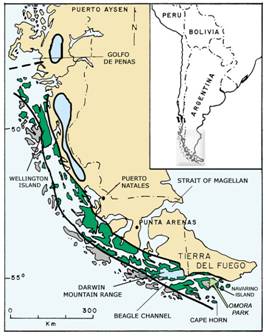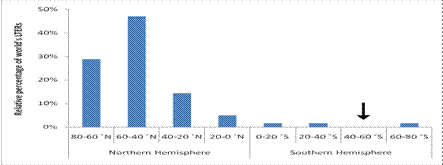 Until the 20th century, high-latitude ecosystems in southwestern South America remained
largely free of direct modern human impact due to their remote location, lack of terrestrial
connectivity, and restricted access to areas under control of the Chilean navy. This
region includes the Magellanic sub-antarctic evergreen rainforest ecoregion (49-56o
S), which recently has been identified as one of the world's 24 most pristine ecoregions
by Conservation International. However, at the beginning of the 21st century, construction
of new access roads through primeval forests has increased the connectivity of this
region with the mainland, and the Chilean navy is significantly reducing its presence.
Concomitantly, the sub-antarctic region is now facing impending threats from various
national and international development projects. The major ones include damming of
several important rivers to generate hydroelectric power demanded by industrial growth
in central Chile, broadening of the present road network, expanding the salmon farming
industry into pristine fjords, lakes and estuaries, increasing unregulated tourism
on uninhabited islands, and rapidly spreading exotic species (e.g., the North American
beaver and mink).
Until the 20th century, high-latitude ecosystems in southwestern South America remained
largely free of direct modern human impact due to their remote location, lack of terrestrial
connectivity, and restricted access to areas under control of the Chilean navy. This
region includes the Magellanic sub-antarctic evergreen rainforest ecoregion (49-56o
S), which recently has been identified as one of the world's 24 most pristine ecoregions
by Conservation International. However, at the beginning of the 21st century, construction
of new access roads through primeval forests has increased the connectivity of this
region with the mainland, and the Chilean navy is significantly reducing its presence.
Concomitantly, the sub-antarctic region is now facing impending threats from various
national and international development projects. The major ones include damming of
several important rivers to generate hydroelectric power demanded by industrial growth
in central Chile, broadening of the present road network, expanding the salmon farming
industry into pristine fjords, lakes and estuaries, increasing unregulated tourism
on uninhabited islands, and rapidly spreading exotic species (e.g., the North American
beaver and mink).
 We conducted a survey of global LTERs by latitude, and found that no official sites
were as of yet present between 40-60os. In spite of its outstanding biodiversity and
ecosystem attributes, the sub-antarctic ecoregion of South America is located within
the only latitudinal range (40-60oS) that completely lacks international long-term
ecological monitoring at the global scale today. We hope to address this with the
formation of the new Chilean Long-Term Socio-Ecological Research Network.
We conducted a survey of global LTERs by latitude, and found that no official sites
were as of yet present between 40-60os. In spite of its outstanding biodiversity and
ecosystem attributes, the sub-antarctic ecoregion of South America is located within
the only latitudinal range (40-60oS) that completely lacks international long-term
ecological monitoring at the global scale today. We hope to address this with the
formation of the new Chilean Long-Term Socio-Ecological Research Network.